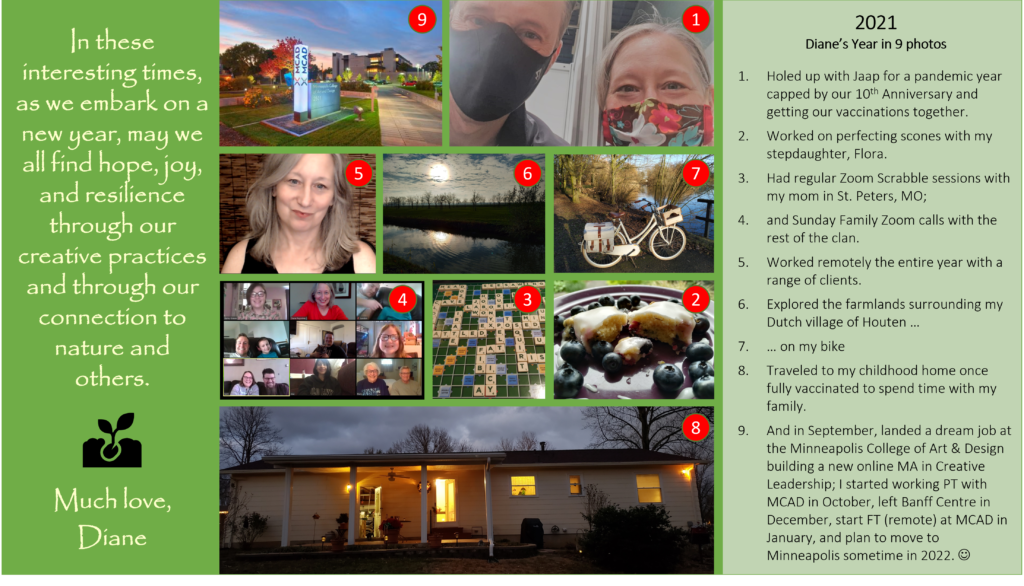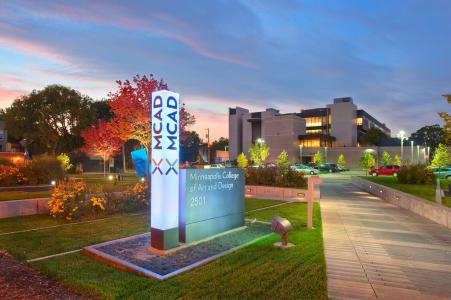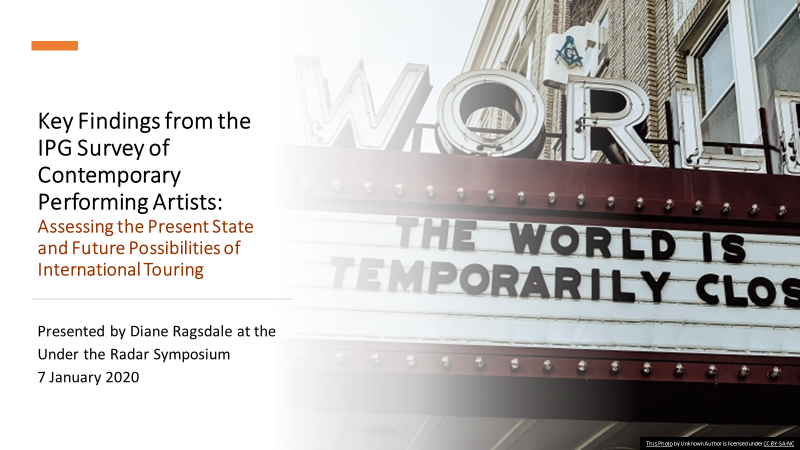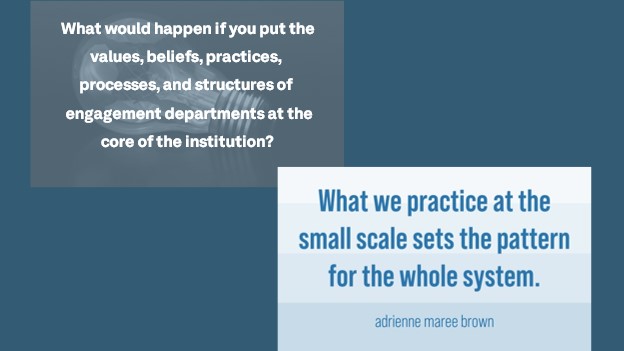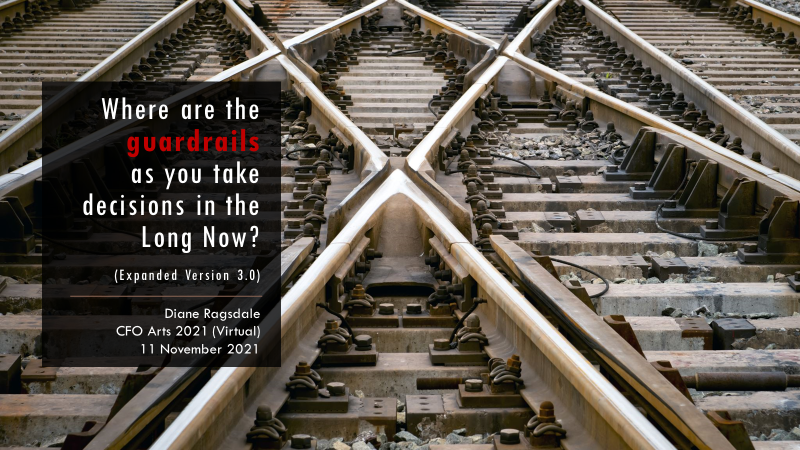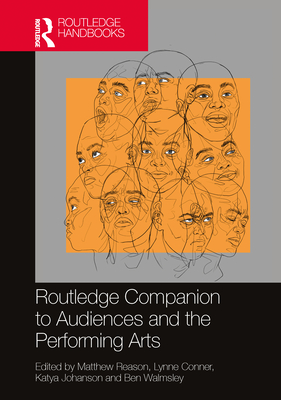In 2021 I took a hiatus from Jumper. I didn’t set out to do so; but 2021 was, to a great extent, a year spent strengthening my skills in listening and holding space for others; reading books that had been sitting for months if not years on my nightstand; figuring out with others how to “do†collective leadership; and tending to relationships—strengthening them, (re)-building them, transforming them, or consciously (and with as much care as possible) letting them go. I continually felt myself, by necessity, detaching from a focus on deliverables and products and instead slowing down and focusing on people, processes, and principles.
I thought I might start the year by sharing some takeaways and reflections from my work in 2021, followed by a handful of questions I am sitting with at the top of 2022. But first, a bit of happy news …
Building a New MA in Creative Leadership at MCAD
Among my projects in 2021, in Q1 I did a bit of consulting with the Minneapolis College of Art & Design on the curriculum for a new program.
This is not the first time I have consulted on curriculum design with a college or university; however, quite happily for me, this particular consultancy eventually turned into an opportunity for me to join the MCAD community.
I am thrilled to now be building a new MA in Creative Leadership there, for which I will serve as program director and to which I will additionally contribute as a faculty member and scholar. Here is a Hyperallergic sponsored post that provides a nice summary of the program and its goals.
Now, to the reflections and questions …
On the Value International Presenting Houses & Festivals Now
In summer 2020 I was invited to work with an informal group of US presenters of international performance, who had begun to meet regularly to discuss challenges, strategies, and ways they might collectively draw attention to the value of international cultural exchange and the potential ramifications of its loss as a result of the pandemic. Over time they formalized as the International Presenting Commons and began to recruit others to join their conversation. You can read about their work on a special section of the HowlRound website, here.
In addition to meeting facilitation and sense-making, as well as supporting the development of the values section of the IPC website, I worked on two key projects with the group: an artist survey and a panel discussion on innovations in festival presenting.
Artist Survey Presentation at Under the Radar
In late 2020 I helped the group undertake a survey of artists and in January 2021 I had a 10-minute spotlight at the Under the Radar Creative Summit (online) to present a power point conveying the key findings from that survey (see this UtR Creative Summit video from ~2:24-2:34).
While it is important not to generalize from the findings given that we employed convenience sampling, some of the themes that emerged in the survey provided topics for discussion and further exploration. Among them:
- While the pandemic devastated necessary infrastructure at many individual companies, many artists responding to the survey were able to adapt artistically and financially. Among the factors that appeared to influence the relative state of welfare of artists were geographic location (including dependence on air travel to tour and access to various forms of pandemic recovery support), new media skills and access to tools and Internet, and the nature of the creative work.
- Those surveyed were evenly divided on whether they were enthused (or not) about the digital turn during the pandemic; but even those who expressed enthusiasm were not advocating for digital per se. Rather, they were eager to explore creative possibilities, to connect globally with new and more diverse collaborators and audiences, to gain new access to knowledge and cultural experiences, and to reduce their carbon footprint.
- While many respondents indicated they expected to return to touring many also indicated that they expected to make changes (in some cases significant) to the ways they make and tour work in the future. Anticipated changes at the time of the survey included: making smaller shows, having longer residencies, and touring closer to home—in large part because of the combined influence of the pandemic and the climate crisis catalyzing a recalibration of personal/professional means and ends.
- A recurring theme was that artists would like to see improved systems of support for artists and improved (less transactional) relationships to presenters and their communities.
- Finally, while cultural exchange appeared to be as important as ever (for its own sake as much or more than the income it provides), there were real questions and concerns expressed about international touring per se and the form that cultural exchange can or should take in the future.
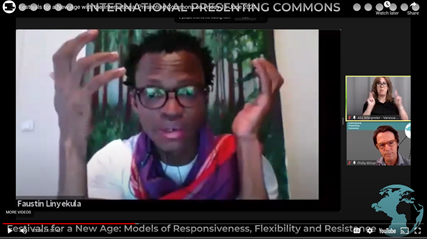
Festivals in a New Age: Models of Responsiveness, Flexibility and Resistance
In June a small group of us working with the International Presenting Commons (IPC) created an online event with HowlRound focused on innovations among a range of international festival presenters. You can watch the entire event here. Some of my key takeaways from the fantastic speakers:
- Festivals are not simply platforms for the presentation of work. In the present moment they hold the potential to initiate, shepherd, host, and hold space for critical local and global conversations; to bridge, translate, amplify, and connect voices across divides; to foster collective imagination, interrogate the taken for granted, heal harms, incubate the new, and steward change.
- To realize this potential a new set of values needs to be centered. Festivals are being called upon to become more artist-centered, caring, flexible, joyful, improvisational, relational, collaborative, democratic, decolonized, equitable, inclusive, sustainable, locally rooted, and responsible.
- Given the multiple crises of the moment, particular attention needs to be paid to protecting the capacity of artists to create; to enacting more ethical, transparent and user-friendly contracts and agreements; to updating outdated language/concepts and inequitable and unsustainable policies, models, structures, and practices; to advancing democratic cultures and fostering genuine exchange; and to exploring the capacity for digital and hybrid forms of producing and distributing work to reduce harms to the environment and increase access to both the tools and fruits of creation.
- A key conversation at this moment is focused on necessary decolonization and expansion of the Western European aesthetic values that have historically underpinned many institutions and to the harms of cultural exchange that is not reciprocal (i.e. that results in cultural domination by the US). As a result, many are embracing (or are seeking to explore) decentralized curation models. Many are also turning attention locally, even as they recognize the importance of global exchange. Rather than transcontinental exchange they now see local diasporic communities as a tremendous gift/asset and source for necessary and transformative cross-cultural exchange.
Takeaways from My Work with Three Sets of Cultural Leaders in CA
#1. Catalyzing Engagement.
The year began with my wrapping up a 22-week engagement with a group of 10 cultural organizations in California. In collaboration with Karen Ann Daniels and Robert Martin, we designed an initiative that we conceptualized as a thought experiment centered on a single question:
In the midst of the disruptions of 2020, when the core of many cultural institutions has been hollowed out, what would happen if we put the values, beliefs, practices, processes, and structures of engagement departments at the center of the institution?
Among other work, participants used the time to listen deeply internally within and across departments; and when they felt ready, they turned their attention to the community and listened deeply to their partners and other stakeholders. For many, the internal work was THE work. It was both challenging and rewarding for artistic, marketing, management, and outreach personnel of institutions to sit together to talk about concepts like engagement, community, audience development, outreach, and education. How to define them? Are they harmful (in the sense of being holdovers from colonialism)? What to do about conflicting conceptualizations and goals? And a whole host of other questions.
The original premise of this program still strikes me as one worth pursuing. What happens if we apply the values upheld and applied in engagement departments across our institutions? Might we start with a single process in the institution and make this change?
#2. Cultural Leaders in Conversation.
Twice this year I was invited to design a two-day workshop for participants in an executive leadership program run by the association that produces the Canadian Arts Summit, Business/Arts. In advance of creating the workshops I asked if I might interview each of the participants for 30-40 minutes to get to know them a bit and check-in on their states of mind, current challenges, goals, needs, etc.
A wide range of topics, challenges, and goals emerged which I synthesized and shared back with the groups, which then went through a collective process of determining the topics they would most like to discuss. Here are the 5 topics that emerged across the two groups:
- How to foster belonging and manage people while working virtually?
- How to lead and collaborate at the same time? How to make shared or distributed leadership work in practice?
- How to address conflict in a healthy way (especially as it relates to flexibility versus accountability)?
- How to build confidence in the value of ongoing hybrid practices?
- How to radically transform our assumptions in terms of organizational structure, diversity, and power dynamics?
I wager these are among the critical questions that will be relevant in the arts sector for years to come.
#3. The Creation of a Faculty Ensemble and A Community of Inquiry, Practice and Care.
Since 2017 my work at the Banff Centre has been incredibly rewarding, due to the subject of the program–helping leaders in the arts and cultural sector respond to a changing cultural context–and due to the beautiful and talented faculty, participants, and staff of the Cultural Leadership Program. Although the CLP was in hibernation much of pandemic –awaiting staff and other resources to be restarted–the time was not lost. I used much of the past two years to focus on two things:
A Shift to Collective Leadership
From 2018-2020 I was a co-director of the Cultural Leadership Program–first with Howard Jang and then with Lexi McKinnon. For the most recent (2019-2020) iteration of the CLP, Lexi and I worked together not only to co-facilitate the program but to consciously braid Indigenous and Western perspectives and practices. In examining the evaluations of the program, it became clear that a huge value for the participants was witnessing this shared leadership and braiding of worldviews in action.
In 2019, when I wrote a memo proposing a philosophy of cultural leadership to help animate our work I adopted the position that Cultural Leadership was a collective capacity; and in 2020 as I began to imagine a next evolution of the program I wanted to challenge us to model this idea by creating a genuine Faculty Ensemble–a diverse collective of 6-8 individuals who would work as co-equals to co-create a next online version program, adapted to the current moment, from the ground up. Throughout the year, we also undertook surveys and brought in alumni of the program to provide feedback and feedforward as we sought to iterate the curriculum in a way that would be maximally valuable and values aligned.
This was slow, sticky work. It was not easy work. It was messy work. It was also joyful and meaningful work that I am confident will bear fruit for years to come even though the Cultural Leadership Program was recently cancelled and our Faculty Ensemble has been disbanded as a result.
Piloting of an online “community of inquiry, practice, and care”.
I have been interested in creating structures and spaces for ongoing exchange, learning, and support with and among students ever since I created my course Approaching Beauty for business students at UW-Madison in 2015. The pandemic year finally provided the opportunity to try out this idea. Since we were not given the green light to launch a new public program at Banff Centre in 2020 it seemed a perfect time to develop a mechanism for better supporting and connecting alumni of the program.
I am not the first to observe that too often leadership programs end and participants return to their individual workplaces and something critical is lost. It’s not just the camaraderie and conversations and care–though those are critical–it’s the potential of what might be co-created if such groups were to continue to gather to gain new necessary skills and knowledge, discuss issues of the moment, learn from each other’s successes and failures, and collectively research, develop, and prototype new ideas. So in November we (the CLP Faculty Ensemble and Producing Team) managed to undertake a small pilot of this idea at Banff Centre. We called it the Cultural Leadership Commons and we used the Mighty Networks platform.
While it was a modest first effort–a knee-deep wading into the water rather than a cannonball–I learned a ton and am now more interested than ever to further develop this concept at MCAD and in other contexts.
A Podcast Episode, 3 Panel Conversations, and a Keynote
I had the great privilege and pleasure to contribute to several events this year. If you click on the hyperlinks you can listen, watch, or read my remarks.
In April I was a guest on the new podcast, The Three Bells, exploring challenges and possibilities at the intersection of culture and urbanism. I had a great conversation with Stephanie Fortunato on Transformational Leadership, after which AEA’s Adrian Ellis weighed in to share his reflections.
Also in April, I moderated a panel featuring Shannon Litzenberger, Sophia Park, and Joann Lee Wagner for Work. Shouldn’t. Suck on Mental Health and Well-Being Amid a Global Pandemic.
In May 2021 I was a co-panelist with Sanjit Sethi (president of the Minneapolis College of Art & Design) for an event hosted by the Museum Trustee Association. The MTA published my remarks here, which I continued to develop and expand for an annual conference of Arts CFO’s, at which Ben Cameron and I spoke (virtually) in November 2021. You can read a transcript of the full keynote (and see the PPT slides) here.
In June, I participated in a panel for the Festival Academy in Dusseldorf on the topic of Festivals, Inequality and International Collaboration. You can read my remarks here.
Finally, in September I was one of three respondents to a major report written by Canadian scholar, artist & cultural institution leader, David Maggs, called Art and the World After This. You can read the executive summary here and the entire report here. I was asked to respond to a section of the report titled, Is this an Ecosystem or Zoo? in which Maggs asks “how ‘rewilding’ practices from ecology, used to restore ecosystem health, might be applied to Canada’s cultural ecology as well.” You can read my remarks here or, if you have time, I encourage you to watch the entire panel discussion to hear Maggs cover the key ideas in his report and hear my excellent co-panelists, artist Marcus Youssef and NESTA’s Director of Creative Industries Policy and Evidence Centre, Hasan Bakhshi.
Beyond these presentations I taught my workshop in Aesthetic Values in a Changed Cultural Context for Yale University’s Theater Management MFA; worked with an arts organization facing the question of whether to persist and evolve, or wind-down, in anticipation of the founder’s departure; and facilitated the first of an anticipated series of conversations with a university college examining its culture and structure as part of a strategic planning process.
BOOKS READ
People often ask me what I’m reading. Here is a list of 35 notable books I found the time to read these past 18 months.
CREATIVITY / ART RELATED
- A Field Guide to Getting Lost by Rebecca Solnit (this was a re-read)
- Artful Leadership: Awakening the Commons of the Imagination by Michael Jones
- Culture Crash: The Killing of the Creative Class by Scott Timbers
- Far From Respectable: Dave Hickey and His Art by Daniel Oppenheimer (I highly recommend for fans of Hickey, who passed away recently.)
- How to Study Art Worlds: On the Societal Functioning of Aesthetic Values by Hans van Maanen
- On Becoming an Artist: Reinventing Yourself Through Mindful Creativity by Ellen Langer
- The Courage to Create by Rollo May (re-read for the first time since college)
ON NEXT STAGE MANAGEMENT / LEADERSHIP
- Better Work Together: How the Power of Community Can Transform Your Business by Susan Basterfield and Anthony Cabraal
- Emergent Strategy: Shaping Change and Changing Worlds by adrienne maree brown
- Manifesto for a Moral Revolution: Practices to Build a Better World by Jacqueline Novogratz
- Orbiting the Giant Hairball: A Corporate Fool’s Guide to Surviving with Grace by Gordon Mackenzie
- Reinventing Organizations: A Guide to Creating Organizations Inspired by the Next Stage of Human Consciousness by Frederic Laloux
- The Essentials of Theory U: Core Principles and Applications by C. Otto Scharmer
- Theories of Social Innovation by Danielle Logue
ON CONFLICT, (DE)COLONIZATION, ARTFUL FACILITATION, AND HEALING DIVIDES
- Decolonizing Wealth: Indigenous Wisdom to Heal Divides and Restore Balance by Edgar Villanueva
- How to Stay Sane in an Age of Division by Elif Shafak
- Resolving Identity Based Conflict in Nations, Organizations, and Communities by Jay Rothman
- Say What You Mean: A Mindful Approach to Nonviolent Communication by Oren Jay Sofer
- The Art of Gathering: How We Meet and Why It Matters by Priya Parker
- The Surprising Purpose of Anger: Beyond Anger Management, Finding the Gift by Marshall B. Rosenberg
- Towards Braiding by Elwood Jimmy and Vanessa Andreotti with Sharon Stein (free download)
- We Will Not Cancel Us: And Other Dreams of Transformative Justice by adrienne maree brown
ON AESTHETICS & BODY/MIND CONNECTION
- John Dewey and Moral Imagination: Pragmatism in Ethics by Steven Fesmire
- Radical Joy for Hard Times: Finding Meaning and Making Beauty in Earth’s Broken Places by Trebbe Johnson
- The Aesthetics of Meaning and Thought: The Bodily Roots of Philosophy, Science, Morality, and Art by Mark Johnson
- The Body Keeps the Score: Brain, Mind and Body in the Healing of Trauma by Bessel van der Kolk
- The Slow Professor: Challenging the Culture of Speed in the Academy by Maggie Berg and Barbara Seeber
- The Strange Order of Things: Life, Feeling and the Making of Cultures by Antonio R. Damasio
ON INTEGRITY, SELF-TRANSCENDENCE, BELONGING, COURAGE, AND CARE DURING THE PANDEMIC
- Braving the Wilderness: The Quest for True Belonging and the Courage to Stand Alone by Brene Brown
- Callings: Finding and Following an Authentic Life by Gregg Levoy (periodic re-read)
- Essentialism: The Disciplined Pursuit of Less by Greg McKeown
- Intimations by Zadie Smith
- The Untethered Soul: The Journey Beyond Yourself by Michael A. Singer
- The Way of Integrity: Finding the Path to Your True Self by Martha Beck
- Wintering: The Power of Rest and Retreat in Difficult Times by Katherine May
FORTHCOMING ESSAY
Finally, I wrote an essay for the forthcoming Routledge Companion to Audiences and the Performing Arts.
The essay is called Post-Show. Counterintuitively, it is not about after-performance talk backs or the like. I am essentially asking whether the arts and culture sector is dominated by a showbiz logic and whether we are overdue to move on from this orientation and place something else at the center of our institutions.
5 QUESTIONS AS I BEGIN 2022
Here’s what I’m sitting with at the moment:
- How do we build our conflict resolution and restorative justice capacities in the arts?
- What would it take to form a national or global community of inquiry, practice and care to collectively consider the problems and opportunities facing the arts and culture sector and imagine possible pathways into the future; to learn together what it means and what it takes, from a practical standpoint, to respond to this moment and be a culture change agent; and to provide mutual support and encouragement to each other—that is, to create a space grounded in love & well-being?
- Should all nonprofit cultural institutions be nonprofit cooperatives? If not, why not?
- So much has been theorized about social innovation but what is meant by cultural innovation? What are its aims? Is it at odds with cultural heritage or are they two sides of the same coin? Much as we have tended to undervalue artistic processes because of the dominance of “design thinking” and its adoption by business schools, I believe we undervalue cultural innovation as a distinctive conceptual, organizational, process, or product development with different aims and outcomes from social innovation. If there is a robust conversation about this and I am simply out-of-the-loop I would love to find that conversation. 🙂
- Where are the levers / mechanisms for holding powerful, too-large-to-let-fail nonprofit 501c3 organizations (or their equivalent in other countries) accountable? When nonprofits are large enough to control their resource and political environments and are no longer serving their missions or the public interests, what are the options for rectifying this situation? Are there any? Or have we created institutions that are unaccountable by design?
To close, here is my New Year’s Postcard with a few updates and a wish for you all. Thanks for reading!
